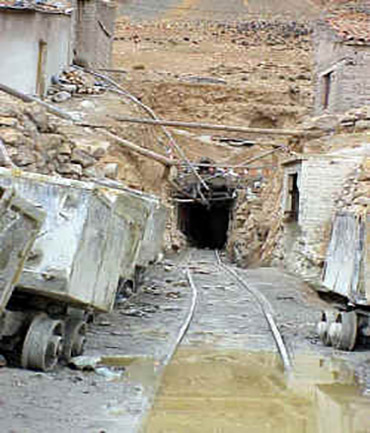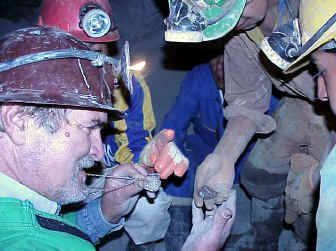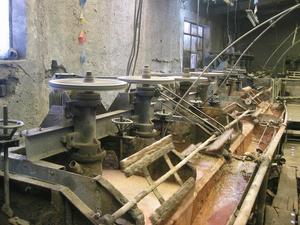Tracing the Origins
Field Trips to Seville Spain and Potosi, Peru - South America

Yvonne and Dominic embarked on a scouting trip to one day film a documentary tracing the origins of the coins they are recovering from beneath the sea, to where the very ore originated and the historic locations where the mints may be, where they were struck.
Captain Dom and his wife, Yvonne traveled to Bolivia and Peru. The trip was an adventure of a lifetime! Why did they choose there to go? " Because Potosi, in Bolivia then known as “Alto Peru and its “Cerro Rico” (meaning the rich mountain) mark the beginnings of the odyssey of adventure for many of our artifacts; silver Spanish colonial period coins – we presently are recovering from beneath the seas, here in Jupiter, Florida. " Potosi is a famous mining town. It is the largest city of its size at this altitude (4,100 meters/13,450 Feet) in the world. Potosi is also the highest city in the world. Why would this remote & desolate location - over 14,500 feet high, in the middle of nowhere be placed upon the World Heritage Place of Historic Places? “Cerro Rico” or the rich mountain was the reason. The population of Potosi in El or Alto Peru (now Bolivia) swelled to over 150,000 souls during the 16th , 17th and 18th centuries because the mountain contained the largest silver find in the world of all times. This made it one of the largest population centers in the world during the Age of Discovery. Most of them were native slaves entering the mines as children – never to see the light of day again…. Even today the miners work as they did three centuries ago for only an amount equal to $14.00 U.S. a week! They make 17 to 18 trips a day pushing carts of ore weighing one to two tons by hand over two to four kilometers into the mountain. Why did we go here? Because this place marks the beginning of the odyssey of many of our silver coins – we are recovering from beneath the seas. It is only fitting that we journey to this place so that we can accurately document and relay the story and journey to where we are presently recovering them.


Destinations
TRACING THE ORIGNS OF THE COINS
We first contacted then retained the services of Dr. Eugene Lyon - a noted Spanish Archival Researcher, whose work lead to the definitive identification of the "Atocha" for Mel Fisher. He was glad to work with us having a personal history of his own with the Jupiter/Stuart area but was quite busy at the time finalizing an article for National Geographic Magazine. It was he on behalf of us that retained the services of Victoria Staples Johnson who was currently living and working in Sevilla, Spain, in the Casa de Contraction - or – (House of Trade) library. Captain Dom reasoned that he and his then girlfriend and Peter Leo should have it be documented as playing an active role in this stage of our adventure in discovery. So, Captain Dom and his then girlfriend were off to the "Spains", which comprised of a whirl wind 21 day trip to all of central Europe, starting in Amsterdam and its maritime museums and then on to Madrid and its Museums, including La Casa de Moneda, (The House of Money), where Peter Leo flew in. They first went to Barcelona, to meet with Xavia Calico, whose family had one of the most complete libraries on Spanish Colonial coinage. Then crossed Spain so the two could meet up with Victoria Staples Johnson in Seville. "The people who are recognized in the history books are the people who won", Captain Dom reasoned, and he was determined that both Peter and he, and their role in the historic event of the discovery and eventual identification was not going to be, “lost in time". Although Victoria was a very accomplished archivist she had little understanding of the seamanship and practical maritime matters. Her first research set us in the false direction of thinking we have possibly discovered a vessel known as the San Francisco de San Antonio but we were later to find, this vessel had successfully made it back to Cadiz, a seaport near Sevilla, Spain. What Victoria failed to comprehend was "who actually controls what a vessel's ultimate mission was" and what its "cargos of merit" may contain....
An Official King's Decree or "Cedula" Proclamed, official avisos that were on the house of trade and thus the King's mission were to be fast sailing heavily armed vessels and not carrying cargos of "treasure".... Captain Dom rationalized.... "Yeah Sure"..... Any vessel's Master chartered or otherwise is not going to put his vessel at risk, sailing it in harm’s way without an "ample reward" for the risk undertaken... So the King's Cedula about "treasure" meant nothing, as that was all we were finding on our shipwreck site!
Spanish exploration of the northern-most region of South America commenced about 1500. This territory encompassed not only present-day Colombia, but also Venezuela, Ecuador and even Panama, all of which were at one time part of Colombia. The Spaniards designated the region as El Nuevo Reino de Granada, the “New Kingdom of Granada.” The Indians called the settlement on the high plain Bacatá, which conquistador Gonzalo Giménez de Quesada later renamed Santa Fe de Bogotá in 1538.1 This was El Dorado, the land of undiscovered treasure, named for an Indian chief who, according to legend, was annointed with gold dust and surrounded by gold and jewels at Lake Guatavita near Bogotá. Though El Dorado was never found, gold was indeed abundant in the area, waiting to be mined; silver was mined in small quantities, but only as a by-product of gold extraction. This fact may explain why all Colombian silver cobs are rare and why Nuevo Reino was the first mint in the Americas authorized to produce gold coins.(sited from Daniel Sedwick)
The most important role of the Lima Mint was to organize and standardize the previous emission, circulation and use of other unlawful coins guaranteeing the political and economic stability of the newly established Vice-royalty.
The use of official coins in Lima and Peru can be traced back to the year 1566. Since the foundation of Lima by Francisco Pizarro in 1535 it was very difficult to execute commercial transactions without any established monetary system. At that time silver and gold bars were used for large transactions, but these were not efficient for small businesses and operations. The gap was filled by a variety of coin shaped objects with differences in weight, nomination and metals used that caused very chaotic conditions.
The Spanish Crown realized the importance of coinage in the colonies and by request of the viceroy of Peru, Diego López de Zúñiga in 1561 the authorization to establish a mint was granted.
The creation of the National Mint was finally started on the 21st of August 1565 by royal decree of Philip II, but it took until 1568 that the operation started in the "Cajas Reales" a building located on the corner of what is today the Government Palace (Main Square in the Lima City.
The Casa de Moneda (House of Money) located in Mexico City is Mexico’s Mint. It’s the oldest continuously operating mint in the New World. It was established by Viceroy Antonio de Mendoza in 1535. It struck gold and silver coins from the massive quantities of precious metal found by the Spanish. It’s two most famous historic coins were Silver Pieces of Eight and the Gold Doubloon of pirate lore.
"Suiting up" for the mines… We first stopped at the miner’s supply store and learned how to make, and light dynamite. We then had to buy cocoa leaves, cigarettes, Coca-Cola and pure-grain alcohol as gifts for the miners and for Tito (the devils brother - uncle George). So with our rubber boots on and our miner’s pants, jackets and helmets on we stopped to learn how to crew the coca leaves - which miners use to keep them alert. It was actually quite gross. You chew a bunch of these leaves (like cows would chew their cud), then you would bite off a small piece of a salt bar. It is here where the activation of the coca leaf, your saliva and the salt gives you the "cocaine effect". However, I did not feel anything but numb lips like Novocain. Oh well . . . when in Potosi, do like the natives do . . . We saw the how they would take the ore and refine and separate the minerals so to get to the real silver. Later we saw how silver in the mountain runs in veins along the sides of the walls.
At the smelter the rock taken from the mines needs to be weighed and analyzed for quantities of silver, tin, zinc and lead. They first crush quantities of the stone and keep dividing if by ten until they have a quantity that can be divided in half, one portion for the head miner and one for the smelter and both are sent to the laboratory to be analyzed for types of minerals. There was also a piece of equipment used to extract the minerals. Chemicals including cyanide are used and the workers need to work on a rotation basis because of exposure to the poisonous gases. After the separation, the mixture goes through further filtering using water and special equipment that shakes the mixture until the lighter minerals come to the top. For silver they use a chemical that sticks to the silver and bubbles up - they then scoop it off the top of the liquid.
We saw the how they would take the ore and refine and separate the minerals so to get to the real silver. Later we saw how silver in the mountain runs in veins along the sides of the walls. At the smelter the rock taken from the mines needs to be weighed and analyzed for quantities of silver, tin, zinc and lead. They first crush quantities of the stone and keep dividing if by ten until they have a quantity that can be divided in half, one portion for the head miner and one for the smelter and both are sent to the laboratory to be analyzed for types of minerals. There was also a piece of equipment used to extract the minerals. Chemicals including cyanide are used and the workers need to work on a rotation basis because of exposure to the poisonous gases. After the separation, the mixture goes through further filtering using water and special equipment that shakes the mixture until the lighter minerals come to the top. For silver they use a chemical that sticks to the silver and bubbles up - they then scoop it off the top of the liquid.
Going into the mines, it was cool and very dark. You could stand and walk one minute, then have to crouch down and even crawl if you were so tall to get through the tunnels. We had just 4 of us in our tour with our guide. We were all wearing the old fashion type of helmets that shot flames. You had to listen hard all the time for fast hand pushed carts filled with ore. They are unstoppable weighing 2 tons when filled and a ton empty. Since you could only see a few feet in front or behind you, you would have to quickly find a recess on the wall to press yourself up against so the miners could shoot past you. There were times when it was quite comical to see us all scrambling first forward then backward to find a spot to stand. Much of the digging is still done by hand, as dynamite is expensive for them. The average daily wage for a miner is just U.S. $4.50/day. The miners work 8 straight hours without stopping for lunch. The cocoa leaves serve to curb their appetite and give them energy to do their work. The average life expectancy of a miner here is 45 years. After about an hour in the mountain we came to the temple of 'Uncle George" or Tito. The devils brother.
This, was creepy! The miners created this 7 foot sitting, statue out of clay and mud and decorated him with coca leaves and confetti type papers. We had to pay homage to him with our coca leaves and grain alcohol. Place a little of both in his hands and on various other parts of his body. This would symbolize that they would be safe, wealthy and fertile. Since they were in the underworld they believed in worshiping the devil and all his relatives.
REVIEW: Tracing the origns of the coins
“There are not enough stars, except maybe on a clear Caribbean night, to rate this blockbuster! What a wonderful journey through the world of explorers, pirates and foodies. Yvonne Addario captains the ship that sails boldly amongst islands of spices and oceans of libations. Make sure this one makes it into your shopping cart. Do it or walk the plank! “
Chef Steven Bart Hetfield

In Explorers Cookbook and Travel Guide- Pirates Edition, the author introduces the regional dishes and breathtaking destinations of the region where once the pirates and explorers roamed. Journey back to the days of wooden ships and the iron men who sailed the oceans in search of adventure, wealth, and knowledge. Readers will learn facts and folklore concerning the amazing people you will meet along the way, all the while sampling savory recipes coming from these exotic lands.
Explorers Cookbook and Travel Guide- Pirates Edition, is the guide to making entertaining recipes and for planning your next trip.
There’s nothing like the tastes of travel!
108 pages. Paperback Retail $24.95 Limited Edition Hardcover Retail $34.95 Purchase from Publisher Adventure in Discovery here Paperback